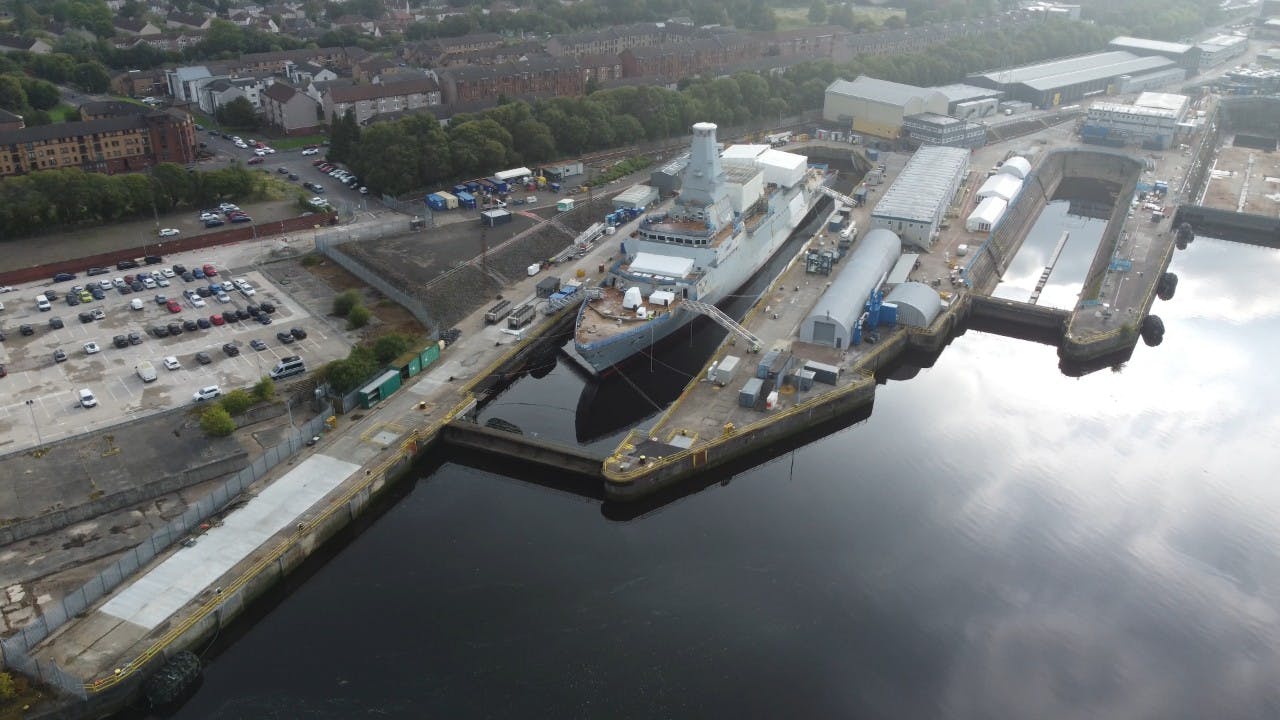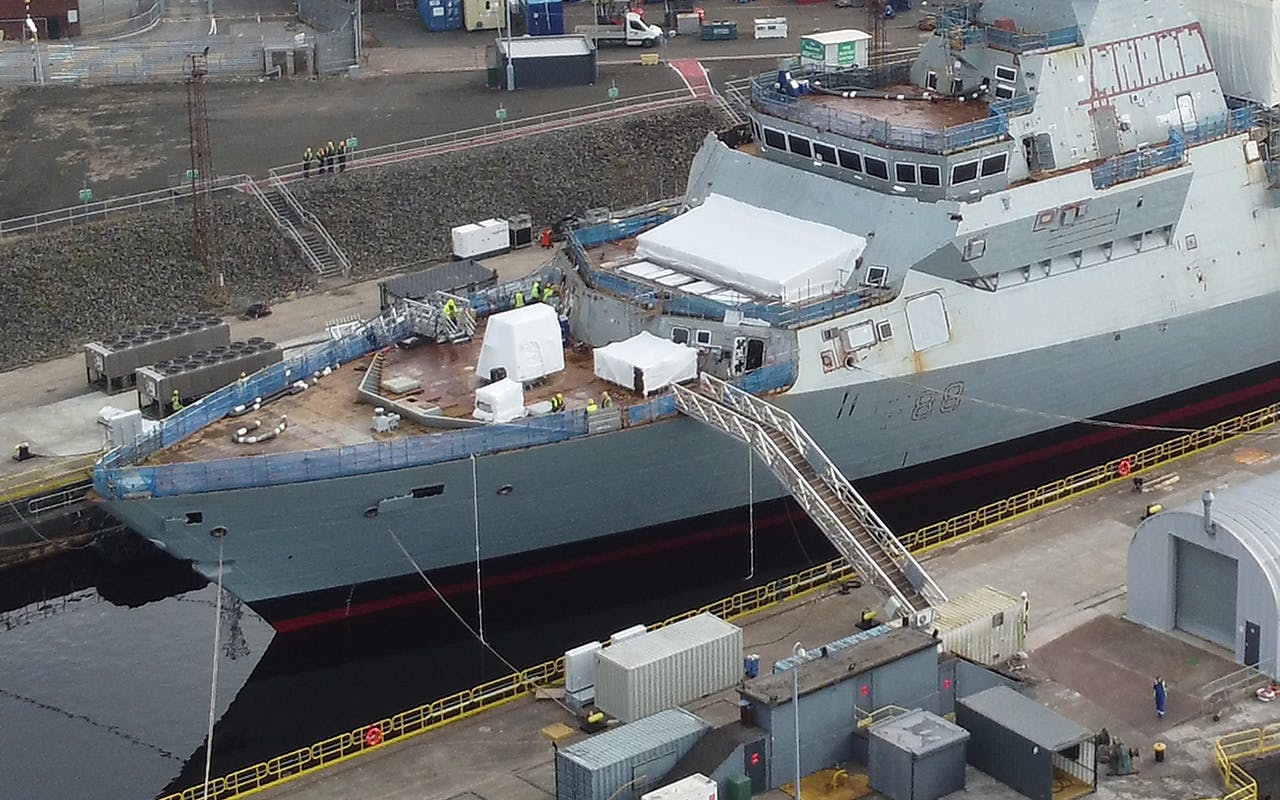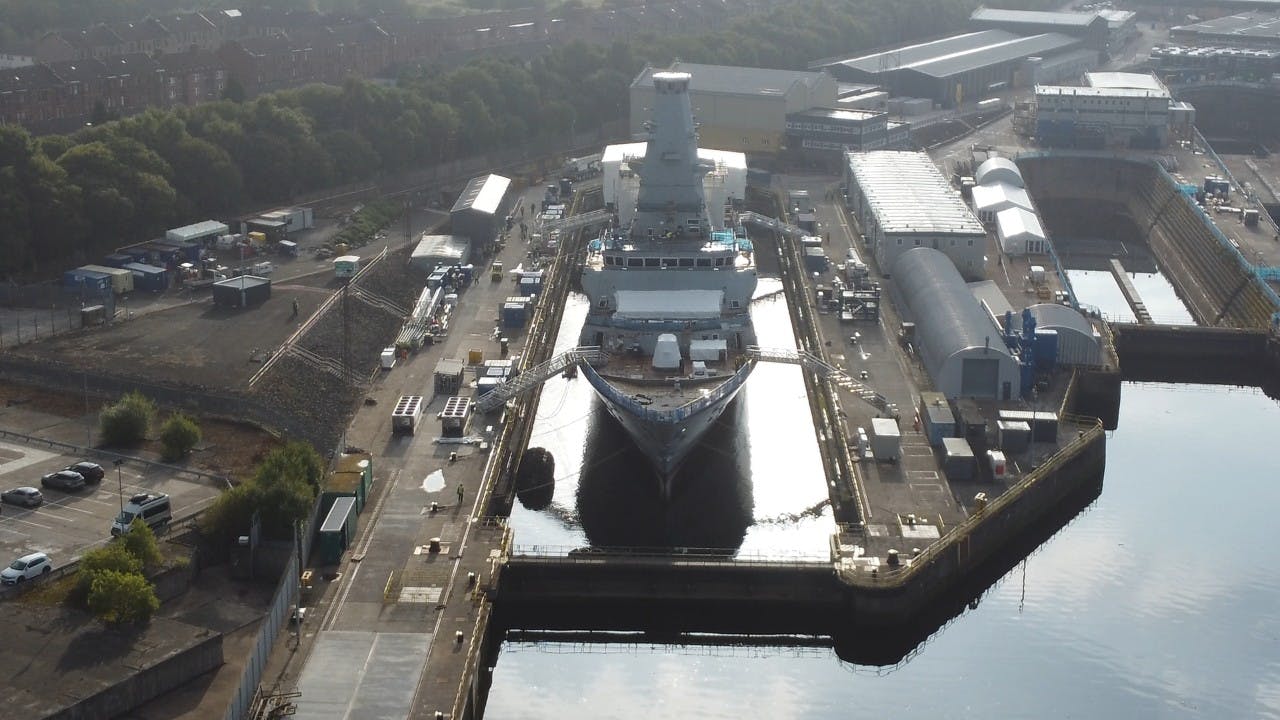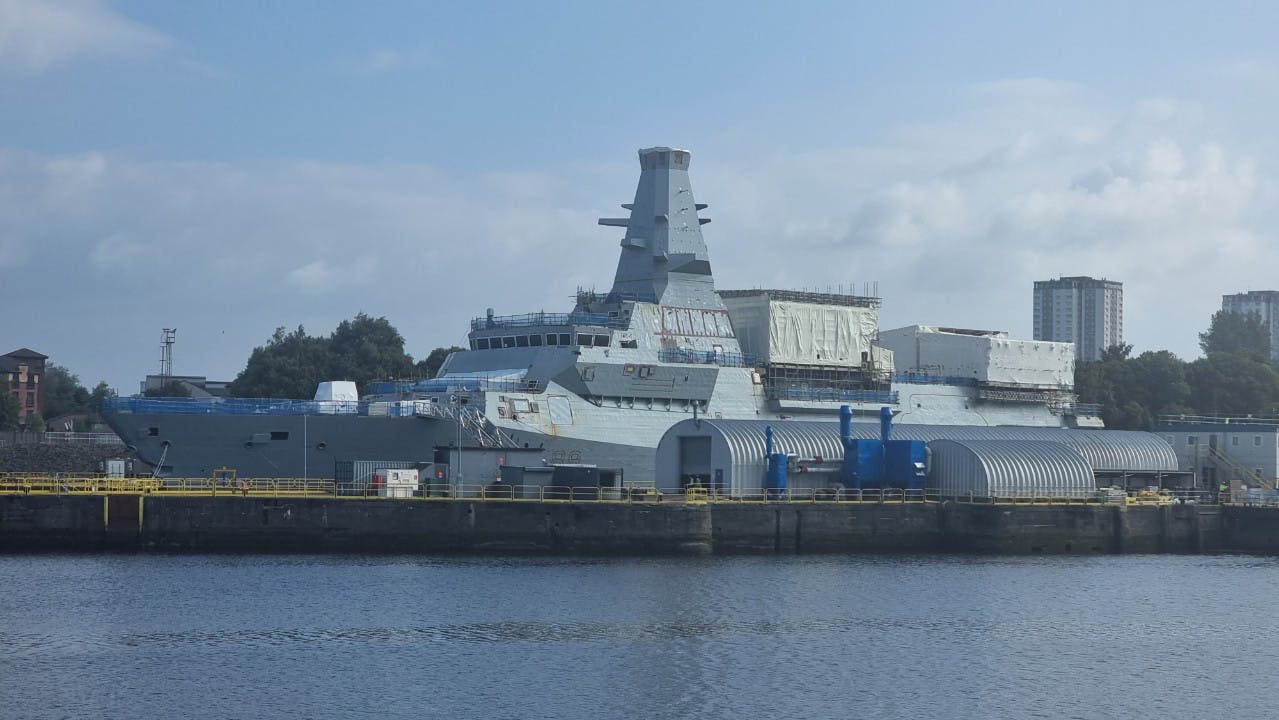Drone shots show HMS Glasgow, currently in an advanced stage of fitting out, as the first of eight Type 26 Frigates gets her main gun.
Commissioning of the vessel is anticipated by late 2026, to be followed by a work-up period prior to reaching initial operating capability.
The Type 26 Frigate, also known as the City-class, is a modern anti-submarine warfare vessel developed by BAE Systems Maritime – Naval Ships. It is intended to serve in the navies of the United Kingdom, Australia, and Canada, replacing the Type 23 frigate in the Royal Navy (RN), the Anzac-class frigate in the Royal Australian Navy (RAN), and the Halifax-class frigate in the Royal Canadian Navy (RCN).
The Type 26 has been adapted into subclasses, including the Hunter-class for Australia and the River-class destroyer for Canada. The estimated cost of the UK’s Batch 1 units is £1.31 billion per unit as of 2022, with Australia and Canada having their own respective costs and contracts.
The Type 26 is notable for its substantial size and capabilities. It has a full load displacement of approximately 8,000 tonnes, with a length of 149.9 metres and a beam of 20.8 metres. The frigate is powered by a Combined Diesel-electric or Gas (CODLOG) propulsion system, which includes a Rolls-Royce MT30 gas turbine, four MTU Type 20V 4000 M53B high-speed diesel generators, and two electric motors.
This propulsion arrangement allows the ship to achieve speeds in excess of 26 knots and provides a range of over 7,000 nautical miles when using the electric-motor drive. With a crew complement of 157, the Type 26 can accommodate up to 208 personnel, allowing for flexibility in different operational scenarios.
The frigate is equipped with a range of advanced sensors and processing systems designed to support its anti-submarine warfare role. These systems include the Type 997 Artisan 3D radar, Kelvin Hughes SharpEye navigation radar, and a combination of towed array and bow sonar systems. In addition, the Type 26 is fitted with electronic warfare and decoy systems such as the IRVIN-GQ DLF decoys, Seagnat, and the Naval Decoy IDS300, alongside the Surface Ship Torpedo Defence system.
These systems are intended to ensure that the Type 26 can effectively detect and counter contemporary maritime threats.
The Type 26’s armament is versatile, with two 24-cell vertical launch systems (VLS) capable of launching Sea Ceptor anti-air missiles, and a separate 24-cell Mark 41 VLS designed to accommodate future cruise and anti-ship missiles, including the BGM-109 Tomahawk. The frigate is also equipped with a 5-inch 62-calibre Mk 45 naval gun, as well as additional weaponry, including two Phalanx Close-In Weapon Systems (CIWS) and various machine guns.
The ship’s aviation facilities are designed to support operations with helicopters such as the Wildcat or AgustaWestland Merlin, featuring a Chinook-capable flight deck and an enclosed hangar. Furthermore, the ship includes a flexible mission bay, which can be adapted for a variety of operational requirements, making the Type 26 a highly adaptable platform for modern naval operations.
How did we get these shots?
The UK Defence Journal successfully completed a fully legal and authorised drone flight over the River Clyde, near Glasgow Airport, on 30th August 2024. The operation, conducted with full approval from Glasgow Air Traffic Control and in compliance with all Civil Aviation Authority regulations, was meticulously planned to ensure the highest standards of safety.
Permission was secured in advance, with all necessary pre-flight notifications made to both local police and ATC. The flight was carried out responsibly, adhering to strict guidelines to avoid any disruption to nearby sensitive areas, including a hospital and helipad.

















Not just the gun but up at the front of the foredeck “shelf” I can see sheets in place where the CAMM are going to sit. Are they starting installation on those?
And what looks like two 12 cell modules to the non Naval geeks on the key sideide? VLS modules?
Pretty sure that’s some sort of cooling or air conditioning unit rather than VLS.
Pipes are leading to a container and the height/diameter is wrong.
Chears👍
Unfortunately, this new class has the same problem of all European ships.
Too poorly armed, especially for the price, I agree it’s not that bad, but still not good.
It is literally a frigate. Not a destroyer, not a cruiser – just a frigate. Generally, across almost every navy, frigates tend to have a medium caliber gun, maybe a single CIWS type weapon, canister launched AShMs and up to 32 VLS cells – that’s the way the Chinese, US, most of Europe** and most other major naval powers do frigates. The only exception would be the Russians Gorshkov Class.
The T-26 is a very well armed for her class; 72 cells total, 48 perfectly capable AAW missiles and up to 24 land attack weapons, AShMs or potentially more AAW weapons. On top of this there is a large caliber gun with fantastic flexibility and capabilities, two dedicated CIWS, dedicated small caliber close in guns, potentially laser weapons and the ability to carry up to two naval helicopters & various USVs and RiBs. Outside of the USN or PLAN fleets this is the level of weaponry (or above that) you’ll find on destroyers. If you were complaining about the FREMMs or original T-31 levels of armament then I’d say fair enough, but for the price of under £1bn each now with the technology and weapon systems fitted to them I don’t think that’s a fair assessment.
Glad someone knows it’s going to be the best missile armed Frigate in the West by a country mile.
French and Italian ASW FREMM 16 VLS Plus 8 AShMs.
Constellation class 32 VLS, 16 AShMs and 21 RAM.
I just hope it gets ASROC or better still the Japanese Type 7 ASW.
Eye-watering price but I’ll bet they will be World class sub hunters which is their primary role. (eventually, some time in the distant future ! )
World class sub hunters?
No ASW missiles, no torpedos, the only ASW weapon is 1 Merlin Helicopter .
Yes World Class.
UKDJ Why do you delete me ?
The ASW missiles are being looked at !
Hunting is not just about the killing.
The Merlin and Stingray are an effective combination.
You’re the first poster I have seen who has suggested they are not world class at what they do, from all the measures taken to quieten the machinery to the detection methods the ship uses to find subs in conjunction with other assets.
Why would an escort want its own Torpedoes to “Hunt” submarines? If it had cause to use them it is a miracle it is not already dead.
I am a skeptic of a country that are always claiming world class for everything. Not even the French do that 😃
Not really that bad a price. £800m for batch 2 is actually really good. I really hope for another 4 ships to take advantage of the class.
I’d tend to agree.
Yes in comparison to B1.
Test
Must have been a strain getting the gun up that gang-plank! Perhaps they used the gun run team? AA
Mobil crane probably.
The rust is a little disconcerting to the eye. Just shows how it’s an endless task protecting these sort of structures. A nice office building at Kings Cross uses rust as an aesthetic seems all the rage now, I assume there is some treatment used to be able to control that mind so it remains just that. Materials science is rather fascinating if a mystery to me.
None of my answers are being allowed now.
I see the rust trend as an excuse not to paint it and call it an aesthetic. I think Network Rail is going down the same route.
Glasgow was laid down in 2017, i would be surprised if it did not had rust.
10 years to get a frigate in service…maybe more.
Cortex is a steel alloy used as cladding which forms a layer of protective rust which prevents further deterioration of the metal and does not require painting.
I’m assuming it’s going to be a mushroom farm for the CAMM?
I like that the bridge have a balcony in front of it. It gives a little bit more protection.
Why are my comments deleted ?
Hello, can someone actually explain why my comments are all now being deleted please ?
get the crew aboard and get it to sea for tials and work up to join the fleet
Andy “Act in haste, repent at leisure” it may be an old saying but it really applies to the Trials of a 1st ship in any class. All the issues that arise are identified and rectified but all the lessons learnt speed up every single ship built afterwards.
Just remember it’s 14 years since any surface warship was built in U.K and this one is completely different to any proceeding one.
And in terms of RN History I doubt anyone would describe what we now have as a fleet, it’s not even a flotilla of assorted vessels.
ABC & Rodney were both Admirals and they’d weep at what we have now.😓
Fabulous shots of Glasgow and the Historic Yarrow Yard at Scotstoun, which I know are very difficult to obtain permission for.
Well done George and Team simply superb !👏🏼
I do have a question and if anyone knows the answer it would be jnteresting ! Are they going to carry out the static power trials in Dry-dock like they did the T45s ?
For those who aren’t aware the T45 were fitted with Paddle drums instead of their propellers and carried out the initial propulsion tests in Dry-dock instead of for waiting Sea Trials. Once complete, de snagged, props fitted and off to sea.
I’ve seen photos of it and it’s impressive, the dock resembled a huge washing machine with a ship in the middle and apparently it shaved months off the trials process.
I’m not sure repeating the T45 propulsion trials model…..PiP?
I can see some milage in that and then including somewhere warm and sunny on the tials itinerary…..just for testing….
I suspect BAe are agreeing to this as it is one in the eye for Babcock. Here is evidence of what we have actually really done gathered by a legit 3rd party.
It’s just a very interesting approach to testing the Power plant in situ rather than waiting for Sea Trials. It ensures it’s properly fettled before it ventures out, and the T45 power plant issue didn’t occur during any trials.
It must have been quite an impressive sight !
Regarding the hot and dry suggestion it’s a bit of a surprise to find out that the French MN have had a long distance voyage to test their ships as the final acceptance trial since before WW1. It’s usually over the Atlantic to their North America islands then the Caribbean and lastly hot and dry off North Africa.
Thankfully the T26 propulsion system is all pretty well known tech !
Is it just me, or is Type 26 about to become a contender for best-looking warship?
Going to struggle with only 8 though…